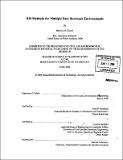RM methods for multiple fare structure environments
Author(s)
Kayser, Matthew R. (Matthew Russell)
DownloadFull printable version (37.99Mb)
Alternative title
Revenue Management methods for multiple fare structure environments
Other Contributors
Massachusetts Institute of Technology. Dept. of Civil and Environmental Engineering.
Advisor
Peter P. Belobaba.
Terms of use
Metadata
Show full item recordAbstract
The rapid growth of Low Cost Carriers (LCC) and their simplified fare structures has created "semi-restricted" fare structures where lower classes are undifferentiated except for price, while higher fare classes are still differentiated by various advance purchase and booking restrictions. The problem this causes is two-fold: first, traditional revenue management systems, which operate based on the assumption of demand independence, will see demand "spiral down" into the lowest booking classes as passengers will buy the lowest available fare in the absence of fare restrictions. Second, airlines must maximize network revenues across two different fare structures, a more-restricted structure used on markets without an LCC presence, and the semirestricted structure for markets where LCC competition exists. This thesis describes methods of dealing with these two problems: Hybrid Forecasting (HF), which forecasts "product-oriented" demand using traditional forecasting methods while simultaneously forecasting "price-oriented" demand for those passengers who will buy the lowest available fare, and Fare Adjustment (FA), which is used at the booking limit optimizer level to account for the sell-up potential of passengers (probability a passenger will book in a higher class if his original booking class is denied). Fare Adjustment allows the airline to deal with multiple fare structures separately. The goal of this thesis is to provide a comprehensive summary of results when an airline uses HF and FA simultaneously in two different multiple fare structure, competitive networks. An alternate Fare Adjustment formulation will also be introduced and tested in these competitive environments. (cont.) Results from the Passenger Origin-Destination Simulator (PODS) demonstrate that in a more restrictive network, HF and FA used in conjunction with one another achieve revenue increases of approximately 2-4% above traditional forecasting methods. In an environment with a fully unrestricted fare structure for LCC markets, HF and FA together generate revenue gains of over 20% above traditional methods.
Description
Thesis (S.M.)--Massachusetts Institute of Technology, Dept. of Civil and Environmental Engineering, 2008. Includes bibliographical references (p. 110-115).
Date issued
2008Department
Massachusetts Institute of Technology. Department of Civil and Environmental EngineeringPublisher
Massachusetts Institute of Technology
Keywords
Civil and Environmental Engineering.